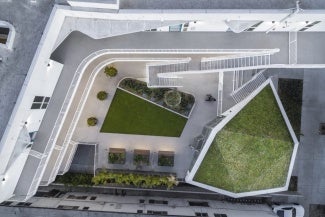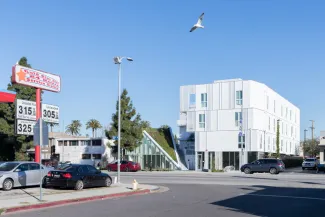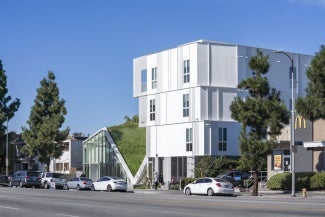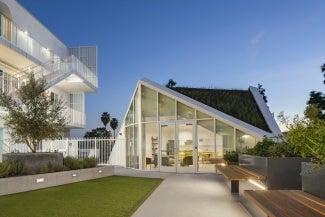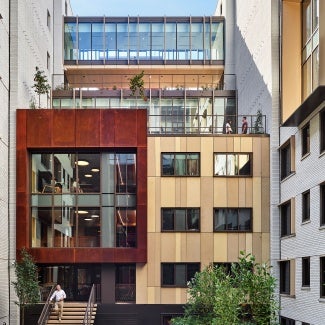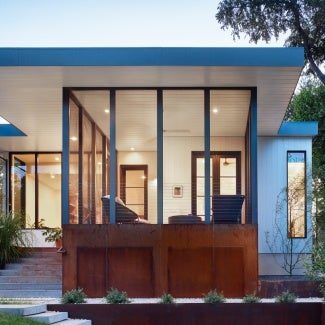MLK1101 Supportive Housing
The award-winning housing design of MLK1101 Supportive Housing in Los Angeles creates a safe and healthy community with services tailored to families and individuals.

Project highlights: MLK1101 Supportive Housing
- Architect: Lorcan O'Herlihy Architects [LOHA]
- Owner: Holos Communities (formerly Clifford Beers Housing)
- Location: Los Angeles
- Category: Excellence in Affordable Housing
- Project site: Not Previously developed
- Building program type(s): Residential - Multifamily, 5 or more units
Just a short jaunt from Los Angeles’ famed Coliseum and the University of Southern California, the LEED Gold-certified MLK1101 Supportive Housing shapes an environment that nurtures health and community. Accommodating families and individuals through 26 one- to three-bedroom units, the project has transformed a vacant lot and improved an aesthetically impoverished block.
The project is a part of a wider strategic plan by the city to address homelessness, an effort championed by the United Way of Greater Los Angeles, which aims to tackle poverty by focusing on housing as a primary solution. MLK1101 Supportive Housing supports the city’s goals by offering a safe and healthy community with services tailored to residents’ individual needs.
The new building’s California contemporary style complements the surrounding neighborhood and is filled with open and functional spaces for residents to enjoy. The design reflects the local context, and its careful massing does not overwhelm the surroundings and allows for a generous mix of indoor and outdoor community spaces. To prioritize social equity and the well-being of residents, the team opted for an L-shaped typology that offers every unit daylight and cross-ventilation, which eases the burden of providing heating, cooling, and artificial light.
Sitting along the bustling and wide Martin Luther King Jr. Boulevard, the building’s required on-site parking is at street level with an elevated community garden and social hub above it. To bolster its street presence, the team tucked the parking behind a storefront space and wide staircase that connects to the community spaces on the second level. The resulting stoop is both a gathering space and a public gesture that encourages resident and neighborhood interactions not often found in supportive housing projects. Additionally, two retail units on the street level generate income that helps subsidize the housing costs while also providing workforce training for residents.
Each of the units includes its own bathroom, kitchen, and living spaces. Residents are encouraged to access amenities in the community room, which has a shared kitchen that hosts cooking classes, potlucks, and group therapy sessions. The outdoor garden, which is filled with drought-tolerant plants and raised beds designed for edible gardens, connects to the community room and living spaces, encouraging residents to socialize and relax.
Framework for Design Excellence measures
Was there a design charrette? Yes
Site area that supported vegetation (landscape or green roof) pre-development: Unknown
Site area that supports vegetation post-development: 43%
Site area covered by native plants supporting native or migratory species and pollinators: 10%
Strategies used to promote Design for Ecosystems: Biodiversity
Is potable water used for irrigation? Yes
Is potable water used for cooling? No
Is grey/blackwater reused on-site? Yes
Is rainwater collected on-site? Yes
Stormwater managed on-site: 100%
2030 Commitment baseline EUI: 11 kBtu/sf/yr
Predicted net EUI including on-site renewables: 44.05 kBtu/sf/yr
Reduction from the benchmark: 70%
Is the project all-electric? No
Level of air filters installed: Unknown
Was a “chemicals of concern” list used to inform material selection? Yes
Do greater than 90% of occupied spaces have a direct view to the outdoors? Yes
Were embodied carbon emissions estimated for this project? No
Estimated service life: 60 Years
Floor area, if any, representing adapting existing buildings: 0%
Ability to survive without utility power: Passive survivability
Which of the following risk assessment and resilience services were provided? None of the above
Has a post-occupancy evaluation been conducted? No, but a POE will be conducted
Building performance transparency steps taken:
Present the design, outcomes, and/or lessons learned to the office
Present the design, outcomes, and/or lessons learned to the profession
Present the design, outcomes, and/or lessons learned to the public
Publish post-occupancy data from the project
Publish lessons learned from design, construction, and/or occupancy
Project team & Jury
Year of substantial project completion: 2019
Gross conditioned floor area: 17003 sq. ft.
Principal-in-Charge: Lorcan O’Herlihy
Project Director: Brian Adolph, Nick Hopson
Project Lead: Dana Lydon, Santiago Tolosa
Project Team: Chris Gassaway, Ghazal Khezri
Project attributes: 34,000 SF with 4,000 SF Park Space
Catherine Baker, FAIA, Chair, Nowhere Collaborative, Chicago
John DeForest, AIA, DeForest Architects, Seattle
Brian Lane, FAIA, Koning Eizenberg, Santa Monica, Calif.
Amit Price Patel, AIA, DIALOG, Vancouver, British Columbia
Michael D. Robinson, AIA, Robi4 Architecture & Planning, San Diego
The Housing Award emphasizes good housing as a necessity of life, a sanctuary for the human spirit, and a valuable national resource. Recipients show the world how beauty, safety, sustainability, and comfort can come together.
Ten projects showcase the best in housing design.

